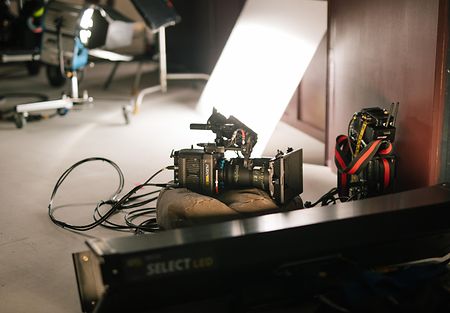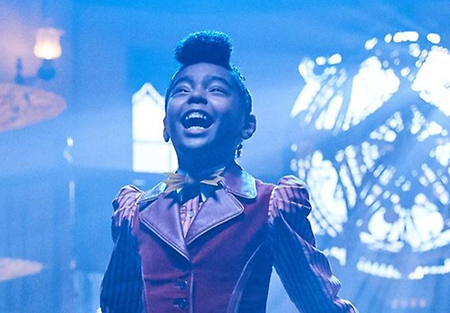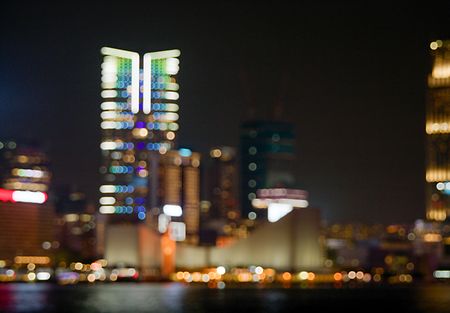“Kantara” (“Mystical Forest”) is a Kannada-language Indian action film, written and directed by Rishab Shetty and shot by cinematographer Arvind Kashyap. The plot traverses several time periods and centers on an ancient land dispute relating to a remote forest village. One of the biggest Indian box office hits of 2022, the film has also received critical acclaim, particularly for its technical sophistication. Arvind Kashyap chose to shoot in large format with ALEXA Mini LF and LF cameras, and Signature Prime lenses. He recently spoke with ARRI about the challenges he faced on the production, which was largely shot on location.
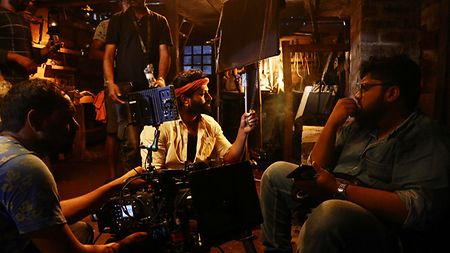
Cinematographer Arvind Kashyap (right) setting up for a shot on set.
How did you select your cameras and lenses for this film?
During preproduction, I did a test with a lot of camera systems mimicking the scenes and lighting challenges we would face in the movie. The ALEXA Mini LF clearly stood above all other systems and hence was my natural choice. After locking in on the camera body, I did a secondary test for lenses and again, ARRI Signature Primes were a clear winner for me.
Once we were shooting, the 47 mm Signature Prime was my go-to lens. We would generally shoot at T2.8 with an ASA rating of 800, and we usually shot with a single-camera setup. Then we would bring in extra cameras, including the ALEXA LF, for special sequences such as the Kambala buffalo race, fight scenes, and the Būta Kōlā dance sequences.

Multiple flame sources light a Būta Kōlā ritual dance sequence, with no ghosting from the Signature Primes.
Why did you want to shoot in large format?
Primarily because of the color science and dynamic range of ARRI’s large-format system. There was no other sensor which came close to the Mini LF in terms of handling the extreme high contrasts this project required. Also, since most of the film was set in low light situations, large format made most sense. We had a lot of matte extensions and VFX planned, so the extra resolution of large format made things easier during post.
There are several different time periods in the story—could you describe them, and how you approached each of them with your cinematography?
We had three main time periods in the movie: the 1840s, 1970s, and 1990s. We definitely wanted each period to look different, visually. The only similarity between these periods was that they were all during the time of film stock, so broadly we wanted the entire movie to look like it was shot on film. For the 1840s, I decided to go with very soft images, with a lot of imperfections. There was quite a lot of color leak happening to mimic the early film stocks. We also decided to add a bit of green in the shadows to emphasize the eerie world and set a mysterious mood. Because the images would be very soft in terms of sharpness, I did high-contrast lighting to balance it out.
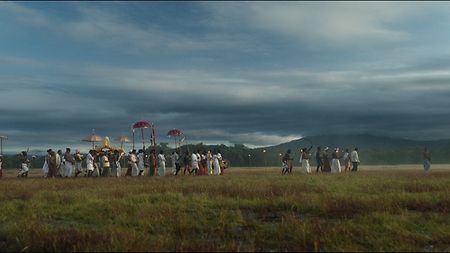
For some scenes the filmmakers pursued a delicate and muted color palette.
The 1970s portion was very small in the film and for this we decided to go with fire as the primary source of light. Most of the close-ups were lit using fire torches. The main time period of the film was the 1990s, and we wanted this to look natural and colorful. The days had to look very picturesque, and the nights had to be mysterious. We kept the day scenes vibrant with a broad color palette, and in contrast we limited ourselves to very minimal colors for the nights, with blues and cyan being dominant.
How important was accurate color capture, and did the combination of the LF cameras with Signatures help you in this regard?
Accurate color capture was vital because there was absolutely no margin of error. Our nights were so dimly lit that a 1/5 stop difference meant seeing only black. After shooting the initial few night scenes, we sent ARRIRAW clips to our colorist for feedback. We were shocked to see the details that the Mini LF could capture in underexposed areas.
The Signature Primes were crystal clear, with minimal glares and artefacts even in backlit scenarios. This made me completely trust the system and I could shoot the rest of the night scenes without any worry or doubts. The skin tones were beautiful in day scenes and the details held in the highlights were magical!
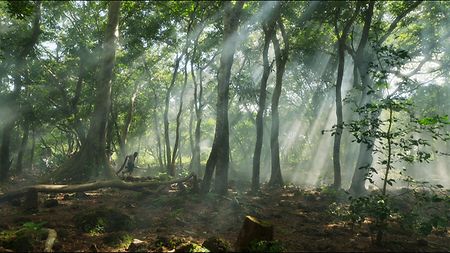
Remote forest locations brought significant logistical challenges.
What was it like shooting on location in Keradi?
Keradi is a remote village surrounded by plains and dense forests. The locations we shot at had makeshift mud roads and no big vehicles could pass. Thus, we did not have access to industrial cranes or moon boxes which were needed for the night scenes. We had to replan our lighting and approach it with a DIY mindset. We found many alternatives to standard lights and built custom setups. We used an array of about 60 huge Chinese lanterns with CFL bulbs to mimic moonlight. And since moon boxes or balloons were not an option in the forests, we had to do a lot of back and side lighting for the night scenes.
Were you also working with director/choreographer Vikram More on the action sequences? How did the Mini LF handle these sequences?
The Mini LF was key in achieving the kinds of dynamic shots we’d planned for fights. We worked with Vikram most extensively during the planning period—composing, shooting, and editing fights during rehearsals with DSLR cameras. With the Mini LF, we could achieve almost every shot we had pre-planned with those smaller cameras. Since most of the fights were shot with a handheld camera, the Mini LF was ideal.
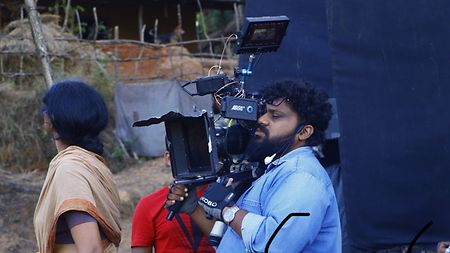
Cinematographer Arvind Kashyap shooting handheld with the ALEXA Mini LF.
How did the cameras and lenses cope with flame-lit scenes and high-contrast daylight scenes?
Because we’d elaborately tested the camera for these scenarios, we were very comfortable filming these after seeing the test results. The Mini LF could hold all the details in flames and fire while still retaining details in deep shadows. And the Signature Primes created very little ghosting from the multiple fire sources. It was the same during the day; the system held amazing details in highlights and produced very accurate skin tones.
What was your dailies workflow, and were you doing any live grading on the set?
We did not have any live grading on the set. And again, due to the remote shoot locations, turnaround of dailies was very challenging. Initially we would send shots to the colorist to grade and get them back, but once we were confident, we relied mostly on the viewfinder to judge our shots.

The sensitivity and dynamic range of the Mini LF allowed flame to be the primary light source in many scenes.
What were the greatest rewards for you on the shoot, and the greatest challenges?
Working with the director Rishab Shetty is something I’ve always looked forward to. His energy is very contagious and his drive pushes all of us to break barriers and explore. We share a lot of creative visions and always work on the same wavelength, so that was very rewarding for me.
The biggest challenge was to shoot a project of this scale with the limited resources we had due to logistical constraints. And probably the second challenge was filming those night scenes in the forest. None of us had prior experience shooting night sequences in natural forests and there were a lot of improvised solutions. I’m extremely proud of those scenes, especially the interval tree falling scene, which was really tough to shoot at night with rain and in the middle of a forest. This is one of the first sequences that was described to me by the director. I am very happy that we could pull it off almost exactly like how we had visualized it.

